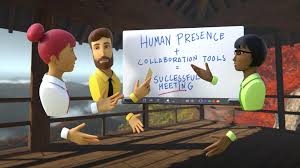Remote working – when will AR/VR deliver true “remote presence”?
Augmented Reality (AR) and Virtual Reality (VR) have the potential to take remote collaboration to the next level through giving people a “remote presence”. Will our current lockdown, and its consequent change in behaviour, be the catalyst to finally get these technologies to deliver?
It was amazing to see how quickly and relatively painlessly companies adapted to the global lockdown. TransferWise had its entire 2,000 employee workforce working from home within a week, ensuring that its systems could support them and that its employees all had access to suitable computers at home. The rise of Zoom/Teams/Meet video-conferencing is well documented, not to mention other collaboration tools such as Slack.
Jack Dorsey has famously declared that employees at Twitter and Square do not ever have to go back the office, and Facebook, with its more than 48,000 employees working in 70 offices across the globe, has declared that half its workforce will work from home (WFH) permanently within the next 5-10 years.
My view is that the long-term shift will be that many, if not most, white-collar workers will have a hybrid office/WFH work situation, where they will go into the office 1-2x per week, providing the best of both worlds (as I have been doing for the last few years)
For now, office time helps to build the company culture, more personalised collaboration and the “serendipitous moments of inspiration” between employees, whilst WFH reduces office and other overhead costs, makes for happier employees with a more flexible schedule, and potentially higher productivity without the commute time. It is also more inclusive for workers living more remotely and not necessarily in the expensive centres, reducing geographical barriers.
Remote collaboration environments using AR, VR or “mixed reality” (combining both AR and VR in a single environment) imagine virtual worlds where avatars join meetings, and participants around the world can manipulate digital objects in real time.
Companies like Magic Leap, Spatial and Sony are leading the charge. “Spatial turns the space around you into a shared augmented workplace. Remote users can collaborate, search, brainstorm and share content as if they were in the same room.” Last August, Magic Leap launched its mixed-reality headset, Magic Leap One, and the hybrid physical-virtual world its users inhabit when they enter that spatial computing system.
In general, spatial computing will enable machines to be responsive to us in real time thanks to a combination of various technologies: sensors, 3-D capture, rendering, algorithms, and wearable displays. This means computers won’t be tethered to a single location, like your desk or closet, but will instead engulf offices, boardrooms, factory floors, and kitchens. Spatial computing means any room can become a computable environment–with you as part of the system.
Facebook’s joint work with Oculus on hand tracking, more realistic avatars, spatial audio, and more powerful wireless technology illustrate how seriously the company is committed to the idea of virtual presence and making it as powerful as possible.
A Wired article published in March, right at the start of the lockdown, laments that VR was supposed to help us work remotely. So where is it? The hype around VR over the past few years could not deliver when we needed it most.
According to research released just before the lockdown, about 3.4 percent of the US workforce works remotely. That is a lot of humans, but it’s a very small proportion of the workforce, considering what might have been achieved at this point in the digital revolution.
An AR/VR revolution could dramatically shift that, as well as the need to travel for business. Our lives would change profoundly once every room we’re in is also a computing environment.
However the reality is that this technology is still on the fringe. There is no doubt that the lockdown shift to greater remote work will give this technology a big push, but, according to Zuckerberg, it will still take another 5-10 years to become mainstream.
